PROFILE OF CATCHES
World Production from Different Sectors of Fisheries and Aquaculture

Total world
fish production was only 19.3 million tonnes in 1950, but it increased dramatically
to 163 million tonnes in 2009 (Figure A2). Marine capture fisheries have always
been the largest contributor to world fish production. In 1950, marine captures were
16.7 million tonnes and accounted for 86 percent of total world fish production. In the
last two decades, marine and inland aquaculture has expanded rapidly, and the relative
contribution of marine capture fisheries to the growing total world fish production has
shrunk. Nevertheless, marine capture fisheries still contributed 49 percent of the worlds
fish production in 2009, the largest sector in comparison with mariculture (21 percent),
freshwater aquaculture (23 percent) and inland capture fishery (6 percent) (Figure A2).
Marine fisheries have experienced different development stages, increasing from
16.7 million tonnes in 1950 to a peak of 87.7 million tonnes in 1996, and then declining
to stabilize at about 80 million tonnes, with interannual fluctuations. Global recorded production was 79.5 million tonnes in 2009 (Figure A2). Rapid development was seen in
the late 1950s and 1960s and between 1983 and 1989. The first boom was believed to be
caused mainly by the post-war shipbuilding expansion in the 1950s, the new technologies
such as steam and motor trawlers in the 1960s, and the extension of jurisdiction to
12 nautical miles by most costal States this is the region that encompassed the oceans most
productive upwelling and continental shelves (Sanchirico and Willen, 2007; Engelhard,
2008). The second rapid expansion was associated with the extension of jurisdictions
from 12 to 200 nautical miles with the establishment of exclusive economic zones (EEZs)
under the legal foundation of the UNCLOS (Sanchirico and Willen, 2007).
After reaching a peak in 1996, global landings decreased gradually, dropping by about
10 percent by 2009. Subsequent fluctuations mainly reflect the variation in catches from
a few highly productive areas, particularly in the Northwest Pacific (Area 61) and the
Southeast Pacific (Area 87). These areas account for a large portion of landings from
pelagic species.
Regional patterns in landings
Based on the average catches in 200509, the Northwest Pacific is the largest contributor
(25 percent) to the global catch, followed by the Southeast Pacific (16 percent), Western
Central Pacific (14 percent), Northeast Atlantic (11 percent) and Eastern Indian Ocean
(7 percent). All other FAO areas contribute less than 5 percent of the global total catch.
World marine fisheries have gone through significant development and changes since
1950 when FAO started collecting fisheries statistics data. Accordingly, the levels of
exploitation of fish resources and their landings have also varied over time. The temporal
pattern of landings differs from area to area, depending on the level of urban development
and changes that countries surrounding that area have experienced. In general, they can
be grouped into three types. The first group are those FAO areas that have demonstrated
oscillations in total catch (Figure A3). They are the Eastern Central Atlantic (Area 34),
Northeast Pacific (Area 67), Eastern Central Pacific (Area 77), Southwest Atlantic
(Area 41), Southeast Pacific (Area 87), and Northwest Pacific (Area 61). These areas
provide about 53.5 percent of the worlds total catch. Some areas in this group may have
shown a clear drop in total catch in the last few years, e.g. Northeast Pacific, but, over the
longer period, a declining trend is not evident.
FAO Statistical Areas Showing Fluctuations in Fish Landings
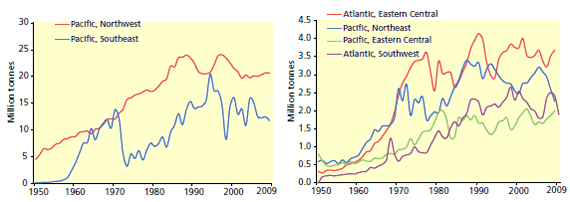
The second group consists of areas that have demonstrated a decreasing trend
in catch since reaching a peak at some time in the past. This group contributes 19.9
percent of global catch on average in the last five years, and includes the Northeast
Atlantic (Area 27), Northwest Atlantic (Area 21), Western Central Atlantic (Area 31), Mediterranean and Black Sea (Area 37), Southwest Pacific (Area 81), and Southeast
Atlantic (Area 47). It is interesting and noteworthy that such declines occurred
at different times: in the Northwest Atlantic in the late 1960s; in the Northeast and
Southeast Atlantic in the mid-1970s; in the Western Central Atlantic and Mediterranean
and Black Sea in the mid-1980s; and in the Southwest Pacific in the early 1990s (Figure
A4). This sequence largely reflects the fact that areas surrounded by the most-developed
countries experienced the earliest decline in catches.
The largest decline was seen in the Northwest Atlantic, where landings dropped by
55 percent from their peak to 2009. The second-largest drop was in the Western Central
Atlantic with 46 percent, followed by the Southwest Pacific with 37 percent and the
Northeast Atlantic with 35 percent. The total catches in the Mediterranean and Black
Sea dropped by 28 percent.
FAO Statistical Areas Showing a Decreasing Trend in Fish Landings
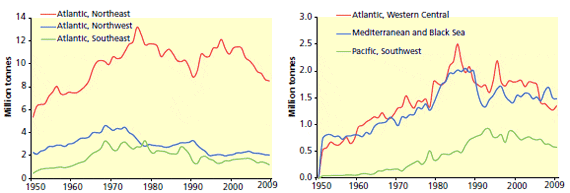
FAO Statistical Areas Showing an Increasing Trend in Fish Landings
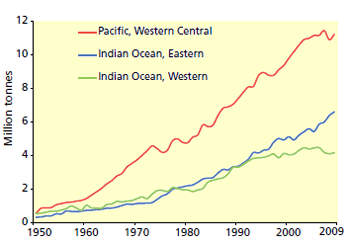
The third group comprises the FAO areas that have shown a continual increase in catch since 1950 (Figure A5). There are only three areas in this group: Western Central Pacific (Area 71), Eastern (Area 57) and Western Indian Ocean (Area 51). They have contributed 26.4 percent of the total catch on average in the last five years. Minor drops in catch have also been seen in Western Central Pacific and Western Indian Ocean in the last two years. However, considering the uncertainty involved in catch reporting and natural fluctuation in fish stock abundance, such declines might have been caused by environmental white noise and need to be monitored over the next few years.
Major characteristics and significant changes
Fluctuations in the abundance of a fish stock are a common phenomenon, particularly
for low-trophic-level species. As a result, the catch of this stock also usually oscillates
in a similar manner. However, at a regional level, fluctuations in catch often appear to
be less marked. This is because: (i) fish stocks within an ecosystem often compensate for
one another as they increase and decrease in abundance; and (ii) aggregation over catches
of all species usually smoothes out the variations of low-trophic-level and short-lived
species. This is because the abundance and catch of high-trophic-level and long-lived
species often vary less.
In the three groups defined above for analysing overall catch trends, the first group
Eastern Central and Southwest Atlantic, and Southeast, Northeast and Eastern Central
Pacific, and Northwest Pacific had large fluctuations in landings (Figure A3). The
largest fluctuation is seen in the Southeast Pacific (Area 87; Figure A3). A drop of about
10 million tonnes occurred between 1970 and 1973. The fish stocks then recovered and
produced an all-time high catch of more than 20 million tonnes in 1994. The catch from
this area dropped by 12 million tonnes again in the subsequent five years (between 1994
and 1998) and was at about 12 million tonnes in 2009, almost as high as its first peak in
1970. The large interannual variation in catch from the Southeast Pacific is caused by
the large proportion of pelagic species in catches from the area. The top three species
were anchoveta (Engraulis ringens), Chilean jack mackerel (Trachurus murphyi) and
South American pilchard or sardine (Sardinops sagax); together, they account for more
than 80 percent of the current and historical catches. They have had alternating periods
of high and low abundance in recent decades. Large catch fluctuations are common
in this region and are mostly a consequence of the periodic climatic events known as
El Nio. El Nio events affect fishing success as well as longer-term stock abundance
and productivity. These and other changes in fisheries production from Area 87 are
described in further detail in Chapter B15 of this volume.
Significant fluctuations were also reported for other regions, although their combined
effect on global catches was less noticeable. For example, in the Northeast Pacific
(Area 67, Chapter B11), fish production reached a peak of 3.6 million tonnes in 1987
and declined to 2.2 million tonnes in 2009, following a slight recovery to 3.2 million
tonnes in 2005 (Figure A3). The Northwest Pacific has shown an oscillation between
20 and 24 million tonnes since the late 1980s (Figure A3). The fluctuations were caused
by catch and, presumably, abundance changes of Japanese pilchard or sardine (Sardinops
melanostictus) and Alaska pollock (Theragra chalcogramma). These and other changes
in total catch and state of resources are further described in Chapter B10.
In the Eastern Central Pacific (Area 77), described in Chapter B13, catches have
fluctuated between 1.2 and 1.8 million tonnes since 1981 (Figure A3).The 2009 catch
was at a peak of about 2 million tonnes, probably because of the recovery of California
pilchard or sardine (Sardinops caeruleus). They yielded 0.8 million tonnes in 2009, an
all-time record high and slightly higher than the high catch of 720 000 tonnes in 1936,
which occurred during the previous high regime of this species. This previous peak
period lasted from the late-1920s throughout the early-1940s. The total landings of the
Southwest Atlantic (Chapter B6) have also fluctuated around 2 million tonnes since
the late 1980s (Figure A3). Argentine hake, Argentine anchovy, Argentine short-fin
squid and Argentine red shrimp are the species that show strong fluctuations in this
area.
Temporal fluctuations in the landings of the second group (declining landings) are
weaker (Figure A4). The landings from the Northeast Atlantic (Chapter B2) have
continued the declining trend seen since the mid-1970s. This has mainly been caused
by the decline in Atlantic cod (Gadus morhua) since the late 1960s, with a bounce back
in the 1990s. It is noteworthy that landings of blue whiting (Micromesistius poutassou),
which increased gradually since the 1970s and reached a peak of about 2 million tonnes in 2003, dropped back to below 1 million tonnes in 2009. Sandeels (Ammodytes spp.)
also experienced a striking and marked drop to below 0.4 million tonnes in 2009 after
peaking at more than 1.2 million tonnes in the mid-1990s.
In the Northwest Atlantic (Area 21), fish production declined to a low of 2 million
tonnes in 1994 (Figure A4), following the collapse of groundfish stocks off eastern
Canada. However, the catch has since stabilized at about 2 million tonnes. The collapse
in Atlantic cod in the 1970s and of American plaice in the early 1990s has been balanced
out by the increase in catches of low-trophic- level species such as American sea scallop
and American lobster.
The Western Central Atlantic (Area 31), Mediterranean and Black Sea (Area 37) and
Southwest Pacific (Area 81) have also experienced a period of declining catches, but
to a lesser extent (Figure A4). Large reductions in catches have been seen in the last
decade for round sardinella, ocean catfish NEI (not elsewhere included) and requiem
sharks NEI in the Western Central Atlantic, and for mullets, blue whiting and common
octopus in the Mediterranean and Black Sea, and for blue grenadier and oreo dories
NEI in the Southwest Pacific.
Of the three areas showing a continuously increasing trend in catch, the West Indian
Ocean (Area 51) and Western Central Pacific (Area 71) have shown some signs of
decline in the last few years (Figure A5), though these may be natural fluctuations.
When examining this trend at the species level, large declines are clear for skipjack and
yellowfin tuna, and for natantian decapods NEI in the West Indian Ocean. However,
decreases in those species were balanced out by increases in the catches of other
redfishes, Indian oil sardine, and giant tiger prawn. Similarly, reductions in sharks, rays,
skates etc NEI and in penaeid shrimps NEI, from these areas was compensated by an
increase in skipjack tuna, threadfin breams NEI and natantian decapods NEI in the
Western Central Pacific. Standing out from all other areas, the East Indian Ocean is the
only FAO area that has not shown any sign of decline in total catch, and no clear decline
in catch has been seen in major fish species (Chapter B9).
Tunas and tuna-like species are collectively the most valuable fishery resources
exploited in the high seas. Their total production is highest in the Pacific Ocean followed
by the Atlantic and Indian Oceans. As discussed in Chapter C1, catches of tuna and
tuna-like species increased from less than 0.5 million tonnes in the early 1950s to an
all-time high of 5.5 million tonnes in 2006. The catch has stabilized at about 5.4 million
tonnes since 2003. Among the species, skipjack tuna (Katsuwonus pelamis) accounts for
about 47 percent, at 2.6 million tonnes in 2009. Yellowfin tuna contributed 20 percent of
the catch (1.1 million tonnes) followed by bigeye tuna at 7 percent (0.4 million tonnes)
and kawakawa at 6 percent (0.3 million tonnes) in 2009.
Total recorded catches from deep-sea fisheries reached a peak of about 3.6 million
tonnes in 2004 and then dropped back to 1.9 million tonnes in 2009 (Chapter C4). The
Atlantic Ocean supports the largest deep-sea fishery, contributing about 80 percent of
the total deep-sea catch between 2000 and 2005, followed by the Pacific Ocean and
Indian Ocean. The dramatic decline can largely be attributed to the decrease in reported
catches of blue whiting in the Atlantic Ocean. The catch of blue whiting decreased
from 2.4 million tonnes in 2004 to about 65 000 tonnes in 2009, owing to a decline
in recruitment, spawning stock biomass and a reduction of quotas (ICES, 2011). The
species that have yielded a high average catch in the last five years (200509) in the
Atlantic Ocean include Patagonian grenadier (Macruronus magellanicus), Greenland
halibut (Reinhardtius hippoglossoides), southern blue whiting (Micromesistius australis)
and ling (Molva molva).
The top five species are blue whiting (= poutassou), contributing 1.5 million
tonnes in 2009 and accounting for 35 percent of the total catch of deep-sea fisheries,
followed by hairtails and scabbardfishes NEI (135 000 tonnes, 7 percent), Patagonian
grenadier (132 000 tonnes, 7 percent), blue grenadier (112 000 tonnes, 5 percent) and Greenland halibut (97 000 tonnes, 5 percent). Patagonian grenadier, Greenland halibut,
blue grenadier, southern blue whiting, orange roughy, and oreo dories NEI have all
experienced clear declines in catch.
A recurring pattern in some areas is the medium- to long-term change in catch
composition following the decline of some fish stocks that had traditionally been
dominant. For example, in the Northwest Atlantic (Chapter B1), catches of molluscs
and crustaceans have increased noticeably following the declines of demersal fishes.
In the Northeast Atlantic (Chapter B2) the reduction in catches from the continuous
decline in Atlantic cod since the late 1960s has been balanced out by the increase in
catches of formerly low-value species, such as blue whiting and sandeels. In the
Northwest Pacific (Chapter B10), the decline in catches of Japanese pilchard or sardine
and Alaska pollock has been somewhat offset by the increasing catches of Japanese
anchovy (Engraulis japonicus), largehead hairtail (Trichiurus lepturus) and squids
(mostly Todarodes pacificus). The causes for these medium- to long-term changes in
the species composition of marine commercial catches can be multifold. These causes
include adaptation of industry and markets to previously unattractive low-valued
species, and the effect of fishing on the abundance of target species and on the structure
of other marine communities. At the same time, environmental changes or regime shifts
affecting the long-term abundance of the various wild fish stocks have occurred. Often,
these effects are confounding and in many cases they are difficult to discern. This is
particularly the case in areas where research and monitoring of fishery resources and
environmental processes are not well developed.
Catch composition
Pelagic species comprise the largest proportion of the global marine catches. Small
pelagics (ISSCAAP Group 35: herrings, sardines, anchovies, etc.) contributed about
22 percent (19.9 million tonnes) of the total catch in 2009 (Figure A6). This share is down
from 29 percent in the 1950s and 27 percent in 1970s. The large pelagics (ISSCAAP
Groups 36 and 37: tunas, bonitos, billfishes and miscellaneous pelagics) accounted
for 19 percent (16.6 million tonnes) of the total catches in 2009. This is an increase in
their share from 13 percent in the 1950s. Demersal fishes (ISSCAAP Groups 31, 32
and 34: flounders, halibuts, soles, cods, hakes, haddocks and miscellaneous demersals)
contributed 12 percent of the total catches in 2009 (10.9 million tonnes), compared
with almost 26 percent in the 1950s and 1970s. Miscellaneous coastal fishes (ISSCAAP
Group 33) increased slightly to 8 percent (7.2 million tonnes) from 7 percent in 2009.
Catches of crustaceans (ISSCAAP Groups 42, 43, 44, 45, 46 and 47: crabs, lobsters, shrimps, prawns,
krill, etc.) contributed 6 percent (5.4 million
tonnes) in 2009, slightly lower than 7 percent
in 2002. Molluscs (ISSCAAP Groups 52, 53,
54, 55, 56, 57 and 58: abalones, conchs, oysters,
mussels, scallops, clams, squids, octopus, etc.)
increased slightly from 6 percent in the 1950s and
1970s to 7 percent (6.2 million tonnes) in 2009.
The proportion of unspecified fish (ISSCAAP
Group 39) decreased slightly with 11 percent of
the total catches (9.9 million tonnes) in 2009.
In world fish production, pelagic defined
here as those belonging to ISSCAAP Groups 34
37 (following Grainger and Garcia [1996]) is
defined to include jacks, mullets, sauries, herrings,
sardines, anchovies, tunas, bonitos, billfishes,
mackerels, snooks and cutlassfishes. Demersal species (ISSCAAP Groups 3133 and 38) include
flounders, halibuts, soles, cods, hakes, haddocks,
redfishes, basses, congers, sharks, rays and
chimaeras. These groups contributed similar
proportions of total marine fisheries production in
1950, 41 percent and 35 percent, respectively. The
remaining 24 percent of the total catch came from
other species, including shrimps, prawns, crabs,
clams, mussels, and marine fishes not identified.
While the total marine fish landings increased with
the development of the fishing industry, landings
from demersal species reached, and in some cases
exceeded, the limit of their potential production
in the early 1970s. Subsequently, catches of
demersal species levelled off below 20 million
tonnes (Figure A7). Production from pelagic
species increased over time, with large fluctuations reflecting both natural variations
in species productivity as well as boom and bust harvesting strategies. Production of
pelagic species peaked at 40 million tonnes in the early 1990s that has been followed by
a decreasing trend. The production of other species continued to increase until 2000
and has since stabilized at about 22 million tonnes. In 2009, pelagic, demersal and other
species represented 46 percent, 24 percent, and 30 percent, respectively (Figure A7).
World Marine Catch by Main Species Groups in 2009 (Million Tonnes and Percentages)
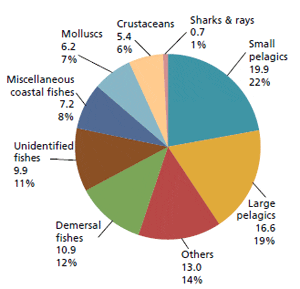
Catches Over Time by Three Groups Pelagic, Demersal and Others
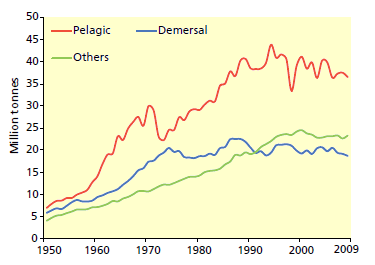
The distribution of landings among species is highly skewed. Among the 221 pelagic
species recorded, the top ten were anchoveta, Atlantic herring, chub mackerel, Chilean
jack mackerel, Japanese pilchard, South American pilchard, capelin, skipjack tuna,
European pilchard (= sardine), and Japanese anchovy, in sequence of the average catch
from 1950 to 2009. Together, they contributed about 50 percent of the total pelagic
landings in 2009 and about 22.5 percent of total global landings.
All the top ten pelagic species have experienced substantial declines in catch, except
skipjack tuna (Figure A8). The most dramatic boombust catch patterns have been seen
in Japanese pilchard, South American pilchard, and capelin. Their historical peak catches
were 46 million tonnes, but were negligible in 2009. Peruvian anchovy has recorded
the largest catches of pelagic species and demonstrated the most dramatic variations. It
had a peak catch of 12 million tonnes in 1969, very low catches between 1970 and 1990,
and resurging back to about 12 million tonnes in 1994, and was still 7 million tonnes
in 2009. Skipjack tuna has been the only species that has shown a continuous growth
in total catch, from 0.16 million tonnes in 1950 to 2.6 million tonnes in 2009. This is a
16-fold expansion in catch over this 59-year period.
Temporal Catch Patterns of the Top Ten Pelagic Species
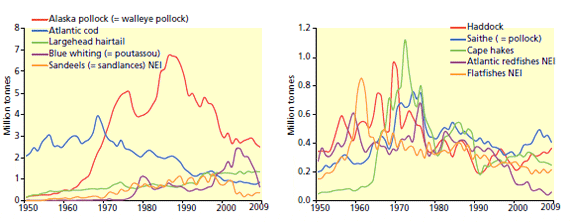
Temporal Catch Patterns of the Top Ten Demersal Species
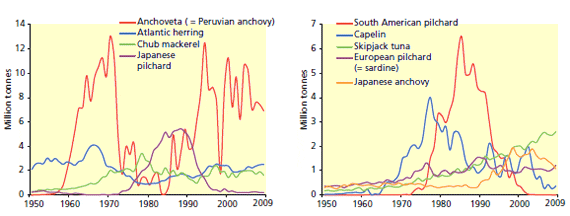
For demersal species, the top ten species were Alaska pollock (= walleye pollock),
Atlantic cod, largehead hairtail, blue whiting (= poutassou), sandeels (= sandlances) NEI,
haddock, saithe (= pollock), Cape hakes, Atlantic redfishes NEI, and flatfishes NEI,
ordered in terms of average annual landings from 1950 to 2009. In general, production
of the top ten demersal species is not as high as that of pelagic species, nor do they
exhibit variations in catch of the same extent. These ten species produced 37 percent
of the total demersal landings in 2009 (Figure A9). The most common pattern across
these ten species has been a decreasing trend in catch. Nine of the ten species produced
a much lower catch in 2009 than their historical highs. Most of them had a peak catch
in the 1960s or 1970s. Largehead hairtail is the only species that has not experienced a
decline, but a levelling off in catch since the mid-1990s.
Species composition varies from area to area around the world. All the major species
groups were represented more or less equally in the Northwest Pacific (Area 61)
(Figure A10). Small pelagics (mostly anchoveta) dominate catches in the Southeast
Pacific (Area 87). In the Northeast Atlantic (Area 27), demersal fishes were the most
abundant, followed by larger pelagics and small pelagics. In the Western Central Pacific,
catches were dominated by larger pelagics, which were also the most abundant group in
the Western Indian Ocean (Area 51). Small pelagics were also dominant in the Eastern
Central Atlantic (Area 34), Mediterranean and Black Sea (Area 37), Western Central
Atlantic (Area 31) and Eastern Central Pacific (Area 77). In contrast, demersal fishes
were the dominant species group in the Northeast Pacific (Area 67) and Southwest
Pacific (Area 81).
Cath Species Composition by Main Species Groups in Major Fishing Areas in 2009
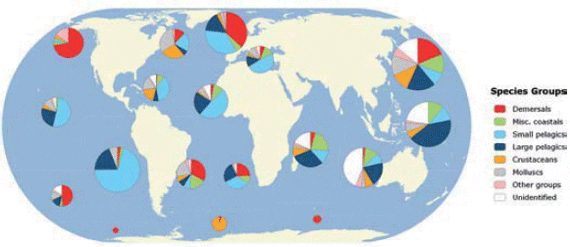
STATE OF EXPLOITATION
Since its first publication of the global review of marine fish stocks in 1971 (Gulland,
1971), the FAO Fisheries and Aquaculture Department has been regularly assessing and
monitoring the state of world marine fish resources. Assessment methodologies used
in its reviews are described in Appendix. As explained there and in the last paragraph
of this section, a modified approach has been adopted for this review. This includes
the reduction of the number of categories of state of exploitation from five to three.
A primary goal of this change has been an attempt to ensure greater standardization
in the assessment methods between regions. At the same time, it also recognizes
the large differences in the amount and quality of data and information available in
different regions. This new method will probably have led to slight differences in
the regional assessments of state of exploitation compared with the result that would
have been obtained with the previously used approach. This could mean that the two
approaches may not be directly comparable. However, this issue should not affect
the aggregated global estimates. These should be comparable, taking into account
the large uncertainties that are an unavoidable feature of any global assessment of the
state of stocks.
The assessment data available to FAO in 2009 from the 17 FAO Statistical Areas
plus the Tuna category has been summarized in Tables D1D19. These tables address
584 stock items, of which 395 stocks were assessed in 2009, representing 70 percent
of global catch. The remaining 189 stocks had either insufficient information for status
assessment or catches with no proper identification, even at the family level, that was
provided in official national statistics. Some species, even where properly identified in
the official statistics, were not monitored or investigated because of the inadequacy
of other data requirements. Species in this group usually correspond to less-abundant
and lower-value species on which research effort tends to be limited. However, there
are also some major stocks and fisheries with limited data, including stocks of mullets,
mussels, shrimps and prawns in several areas, bonga shad (Ethmalosa fimbriata) and
European anchovy (Engraulis encrasicolus) in the Eastern Central Atlantic, Pacific cod
(Gadus macrocephalus) in the Northeast Pacific, and various newly exploited deep-sea
resources.
FAO has always made efforts to standardize the number of marine stocks or species
groups monitored and described for each major fishing area. However, the uneven
availability of information and distribution of catch volumes have limited the number
of stock groups able to be considered per area. In addition, in some parts of the world,
there are relatively large numbers of stocks or species groups whose state of exploitation
is undetermined or not known. The Western Indian Ocean (Area 51) and Western
Central Atlantic (Area 31) are fishing areas with
the highest incidence of stocks or species groups
for which the state of exploitation is reported as
not known or uncertain in the regional reviews
presented in Part B of this paper.
With the development of world fisheries, both
the assessment methods and the data available
for such assessment have changed significantly.
It is noteworthy that this review uses three
categories: non-fully exploited, fully exploited
and overexploited (Figure A11). This decision
was made following recommendations from an
external review panel on the FAO method and
FAOs internal review. It reflects the fact that the
data currently available to FAO for most stocks
do not provide sufficient information for the differentiation between recovery and depleted and between underfished and moderately
exploited. The category of fully exploited represents stocks with an abundance that
falls within a band around the level that can produce MSY. Provided these stocks are
being carefully monitored and managed in a precautionary manner, this is a desirable
status. In comparison with the five categories used in the previous assessments, the
underfished and majority of the moderately exploited stocks have been merged
and now roughly correspond to the new non-fully exploited category. Parts of the
moderately exploited and overexploited stocks under the earlier approach may
have been classified as fully exploited in this new approach and merged with those
classified as fully exploited by both the old and new methods. Finally, both depleted
and recovering stocks are merged into overexploited (for details, see Appendix 1).
Global Trends in Marine Fish Stock Status from 1974 to 2009
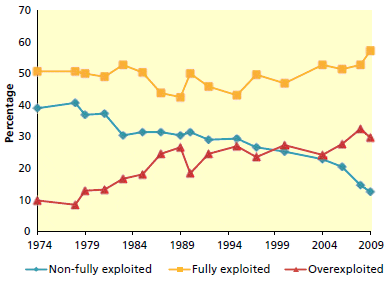
Global stock status
Of the fish stocks assessed, 57.4 percent were estimated to be fully exploited in 2009.
These stocks produced catches that were already at or very close to their maximum
sustainable production. They have no room for further expansion in catch, and even
some risk of decline if not properly managed. Among the remaining stocks, 29.9 percent
were overexploited, and 12.7 percent non-fully exploited in 2009. The overexploited
stocks produced lower yields than their biological and ecological potential. They require
strict management plans to rebuild their stock abundance to restore full sustainable
productivity. The World Summit on Sustainable Development (WSSD) goal demands
that all these overfished stocks be restored to the level that can produce MSY by 2015.
This review suggests that this goal is very unlikely to be achieved, notwithstanding
the good progress made in some countries and regions (Worm et al., 2009). The nonfully
exploited stocks were under relatively low fishing pressure and have a potential
to increase their production. However, these stocks often do not have high production
potential. The potential for increase in catch may be generally limited. Nevertheless,
proper management plans should be established before increasing the exploitation
rate of these non-fully exploited stocks in order to avoid following the same track of
overfishing.
The proportion of non-fully exploited stocks has decreased gradually since 1974, when
the first FAO assessment was accomplished (Figure A11). In contrast, the percentage
of overfished stocks has since increased, especially in the late 1970s and 1980s from
10 percent in 1974 to 26 percent in 1989. After 1990, the number of overfished stocks
continued to increase, but the rate of increase slowed, until the last two assessments,
reaching about 30 percent in 2009. The fraction of fully exploited stocks demonstrated
the smallest change over time. The percentage dropped from about 50 percent at
the start of the series to 43 percent in 1987 and has increased to 57.4 percent in 2009
(Figure A11).
A primary fishery management goal is to control fishing at a level that allows the
fishery to produce sustained annual yields. This yield should be as close to MSY as
allowed by responsible management within the context of an ecosystem approach. This
goal should lead to keeping the proportion of overexploited stocks at zero, as required
by the WSSD goal set in 2002. At the same time, it allows for increasing exploitation
rates on non-fully exploited stocks. This would maximize the sustained contribution
of fisheries to global food security and human well-being. The increasing trend in fully
exploited stocks after 1990 indicates the positive impact of fishery management towards
maximizing production. However, close attention is required to all fully exploited
stocks to ensure that they are not overexploited in the future. Moreover, the increase in
overfished stocks is a cause for concern. It indicates that, at the global level, the WSSD
targets for rebuilding the overfished stocks and implementing an ecosystem approach
are not being met. Nevertheless, the deceleration in the rate of increase of overfished
stocks after 1990 in comparison with the 1980s may indicate some progress in improved management. It suggests that some fish resources
have benefited from the management efforts of
coastal States and the international community.
Percentages of Fish Stocks in Different Status by Major Fishing Areas in 2009
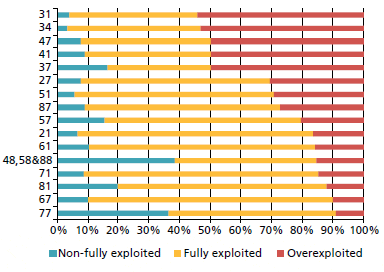
Regional stock status
Development of the fishing industry and management
of fishery resources vary with country and region.
The Western and Eastern Central Atlantic (Areas 31
and 34) had the highest proportion of overfished
stocks, about 54 percent in 2009 (Figure A12). The
Southeast (Area 47), Southwest Atlantic (Area 41), and
Mediterranean and Black Sea (Area 37) had 50 percent
of fish stock overfished. The lowest proportion of
overfished stocks was about 10 percent, seen in the
Eastern Central Pacific (Area 77), Northeast Pacific
(Area 67) and Southwest Pacific (Area 81). Other
Areas had 1530 percent of fish stocks overexploited (Figure A12).
In terms of potential for further expansion, the Eastern Central Pacific (Area 77) and
Southern Oceans (Areas 48, 58 and 88) had the highest proportion of non-fully exploited
stocks, about 38 percent in 2009 (Figure A12). However, these areas are not major fishery
production areas and contributed only 2.3 percent and 0.2 percent of global catch,
respectively, in 2009. The Southwest Pacific (Area 81) and Eastern Indian Ocean (Area 57)
and Mediterranean and Black Sea had about 20 percent of stocks underexploited and may
provide opportunities for further fishery expansion. All the remaining areas had a very
low percentage of fish stocks that have room for expansion in catch.
Differences can also be found in stock status between pelagic and demersal fish
stocks. Demersal stocks had the highest percentage of overfished stocks and the lowest
proportion of non-fully exploited stocks, at 38 percent and 7 percent, respectively, in
2009 (Figure A13). In contrast, pelagic species had only 22 percent of stocks overfished,
but 16 percent non-fully fished in 2009. The percentage of fully exploited species was
54 percent for demersal and 62 percent for pelagic. Overall, these percentages indicate
that pelagic stocks are in better shape than demersal species, with more stocks being
sustainably fished and fewer stocks overfished. The results seem associated with the
biological and ecological characteristics of pelagic and demersal species and with the
history of fishery development. The Others group had percentages for both overfished
and non-fully fished stocks in between those for demersal and pelagic (Figure A13).
For the top ten pelagic species, 30 percent of stocks were estimated to be overfished
in 2009, which is higher than the 20 percent for all pelagics (Figure A13). In contrast,
the top ten demersal species had 43 percent of
their stocks overfished, similar to the average for
all demersal species. However, both pelagic and
demersal top-ten groups had no underexploited
stocks, which is not surprising as large stocks are
more likely to become the target of fishing. They
also attract more effort for management so that they
have a greater percentage of stocks fully exploited.
The above-average percentage of overfished stocks
for the top ten pelagic species probably reflects the
widespread risk of overfishing taking place even
when there are good management systems in place.
This is because of social and economic pressures
to maintain catches even when they may exceed
sustainable levels.
Percentages of Fish Stocks in Different Status by Three Groups in 2009
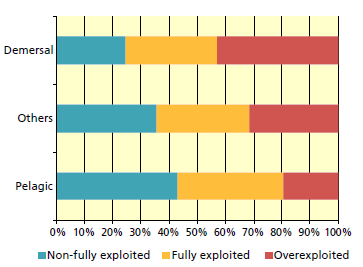
Tuna stock status
Tuna and tuna-like species have high commercial values and support fisheries of a global,
multigear and multispecies nature. All the worlds tuna and tuna-like species are the
subject of research and management by regional fisheries management organizations
(RFMOs). There are five main tuna fishery management bodies: the Western and Central
Pacific Fisheries Commission, the Inter-American Tropical Tuna Commission, the
Indian Ocean Tuna Commission, the International Commission for the Conservation
of Atlantic Tunas and the Commission for the Conservation of Southern Bluefin Tuna.
Tuna RFMOs cover a large part of the worlds oceans, and they involve many countries.
Tuna fisheries are characterized by high commercial value, global nature, and complex
management. They involve many different types of stakeholders, and this frequently
makes management scientifically and politically complex. International management of
tuna and tuna-like species is governed by several legal instruments such as the binding
UNCLOS, the UNFSA (UN, 1995) and the voluntary FAO Code of Conduct for
Responsible Fisheries (the Code) (FAO, 1995a).
FAO has been monitoring the state of principal market tuna stocks as part of its
initiative to assess the stock status of the worlds marine fishery resources. Principal
market tunas include: albacore (Thunnus alalunga), Atlantic bluefin tuna (T. thynnus),
bigeye tuna (T. obesus), Pacific bluefin tuna (T. orientalis), southern bluefin tuna
(T. maccoyii), yellowfin tuna (T. albacares), and skipjack tuna (Katsuwonus pelamis).
They represented about 80 percent of the total catch of tuna and tuna-like species in
2009. Because of their wide distributions, the state of each of these seven tuna species
was assessed at the stock level, rather than by FAO Statistic Area as is done for other
species. FAOs classification is based on a variety of data and information including
those from tuna RFMOs and may not necessarily be the same as those of the RFMOs.
The global annual catch of tuna and tuna-like species has shown an increasing trend
from less than 1 million tonnes in 1950 to about 6.5 million tonnes in 2009. The global
production of the principal market tunas increased relatively steadily from less than
0.5 million tonnes in the early 1950s to a maximum of about 4.4 million tonnes in 2005
and has since stabilized at this level (Chapter C1). In particular, catches of skipjack
have continued to increase up to 2009. Albacore has shown a much weaker increasing
trend since the 1970s, with greater interannual variations. In contrast, yellowfin, bigeye,
Atlantic bluefin, Pacific bluefin and southern bluefin tunas have all shown a gradual
decline in catch after reaching their historical peaks.
Among the seven major tuna species, one-third were estimated to be overfished in
2009, close to the 30 percent for all monitored stocks. Of the remainder, 37.5 percent were
fully exploited and 29 percent non-fully exploited in 2009. This compares favourably
with 57.5 percent and 12.7 percent of the global average.
Uncertainty
All stock assessments involve uncertainty, and uncertainty arises from three different sources: data, methods and the process of applying the methods to the data. Awareness of the degree of such uncertainty helps to understand the reliability of the results and their interpretation. In the 2009 assessment, the uncertainty of each assessment was scored according to one of three categories: high, medium and low (for more information, see Appendix 1). In general, the Northwest Atlantic (Area 21), tunas, Northeast Atlantic (Area 27), and Northeast Pacific (67) had the lowest uncertainty, with 8096 percent of assessed stocks having low uncertainty. These were followed by the Eastern Central (34) and Southwest Atlantic (Area 41) and Mediterranean and Black Sea (Area 37) with about 63 percent of stocks having low uncertainty (Figure A14). In contrast, the Eastern Indian Ocean (Area 57) and Western Central Pacific (Area 71) have the highest uncertainty (84 88 percent), with no stocks assessed as having low uncertainty about their status. This high uncertainty results from a combination of limited data available, the existence of many small stocks for many species and other complexities of assessment in tropical waters. The Southwest (Area 81), Southeast (Area 67) and Northwest Pacific (Area 61) also have a relatively high percentage of stocks for which the assessment was highly uncertain.
Percentages of Assessed Stocks Involving Different Uncertainty Levels by Major Fishing Areas in 2009
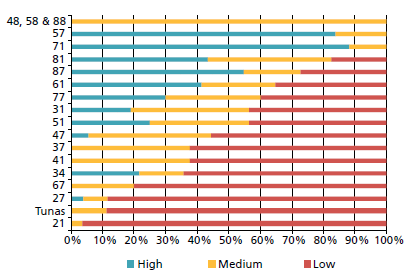
DISCUSSION
The total production of marine fishery resources
has declined gradually after reaching a peak in
landings in 1996. Is it possible to increase global
fishery production any further? One way in
which yields could be increased is to rebuild
the 30 percent overfished stocks so that they
can produce close to their MSY. This should
lead to a net increase in landings. However, it
is difficult to estimate the extent of this increase
because it is not only related to the current abundance of overfished stocks but also
depends on the biological and technical interactions between species. Nevertheless, the
top ten demersal species have 43 percent of stocks overfished. As a result, their 2009
production was only 51 percent of their peak level. This may give some indication
of the scale of catch loss caused by overfishing. However, better estimates of the lost
production will require a combination of stock assessments and ecosystem modelling.
A second approach for increasing global production would be to intensify exploitation
of the non-fully exploited stocks (13 percent of the monitored stocks). To avoid the
same pattern of overfishing that has been experienced with other species in the past, any
attempt to intensify exploitation on non-fully exploited stocks should be accompanied
by precautionary management plans.
This updated assessment suggests that the state of global marine fish stocks is
continuing along its historical trend. There has been a slow but apparently ongoing
increase in the proportion of overexploited stocks and a decreasing percentage of nonfully
exploited stocks, while the number of fully exploited stocks has increased slightly.
However, it must also be noted that progress is being made in some regions, which
should serve both as encouragement and as examples of successful management. For
example, the number of stocks classified as overfished and/or subject to overfishing
showed a fall in Australia from 24 in 2005 to 18 in 2008 (Wilson et al., 2009). Fisheries
in large marine ecosystems such as the California Current and the Eastern Bering Sea
have reduced exploitation rates and rebuilt biomass to or above the level that produces
multispecies MSY (Worm et al., 2009).
Of the three categories describing stock status, the percentage of overfished stocks
is the one of greatest concern. Not only can overexploitation cause negative ecological
consequences, it can also reduce fish production with resulting negative social and
economic consequences (World Bank and FAO, 2009). The need to improve management
of stocks is widely recognized. The WSSD set a target to restore all overfished stocks to
the level that can produce maximum sustainable yield by 2015. The strategic goal of the
2010 Conference of the Parties to the Convention on Biological Diversity is: by 2020
all fish and invertebrate stocks and aquatic plants are managed and harvested sustainably,
legally and applying ecosystem approaches (UNEP, 2010). The UN Millennium
Development Goals (UN, 2010) is also monitoring the proportion of fish stocks within
safe biological limits as an indicator of environmental sustainability. The successful
cases highlighted above demonstrate that effective management is possible. Member
States, the general international community and all relevant stakeholders need to work
together to achieve the agreed goals.
Assessing stock status usually requires
quantitative analysis either through modelling
or monitoring key indicators. Catch data alone
are often insufficient, although they may allow
the use of catch-only methods. It is a common
practice in fisheries that stock assessment is
undertaken to provide the information necessary
for designing management regulations. This is still
true, even when they may range from qualitative
to quantitative assessments. However, assessment
results are not always available to the public. The
RAM Legacy Database compiled the results of
classic assessments on 234 stocks of 124 species
that accounted for about 20 percent of global catch
(Branch et al., 2011). FAO has adopted a spectrum
of methods and extended the coverage to 70 percent of the global catch. There is still 30 percent of the global catch without any formal
assessment. This is mainly because these catches are taken from stocks or species groups
with insufficient information to assess their state of exploitation. Moreover, within the
above, there is a high proportion of the total marine catch without reliable information
on what species are being caught. This catch was recorded in the FAO database as
miscellaneous fishes or marine fish NEI. These landings are termed here as the
NEI group, and the share of global catch statistics attributed to this group increased
to 33 percent in 2009 (Figure A15). Assessing stock status for the NEI group is often
difficult, although not completely impossible. Therefore, greater effort needs to be made
at all levels and stages of fisheries research and management. These actions should range
from improving the identification of species being caught and landed to improving the
information base for the proper assessment of fish stocks as required by the Code. This
code requires that States should ensure that timely, complete and reliable statistics
on catch and fishing effort are collected and maintained in accordance with applicable
international standards and practices and in sufficient detail to allow sound statistical
analysis (Article 7.4).
Temporal Variation in the Percentage of Catches Reported as NEI in the FAO Statistical Database
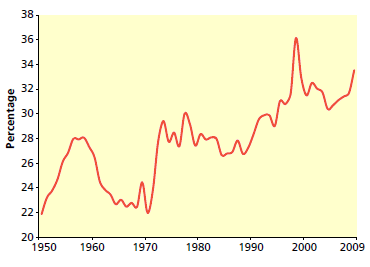
ACKNOWLEDGEMENTS
We wish to thank all the authors in Section B - the regional reviews of marine fisheries resources in FAO statistical areas for their contribution to the data and information presented in this chapter. We are also grateful to Luca Garibaldi and Fabio Carocci for their input in the preparation of data and graphs. Finally, David Milton and Jacek Majkowski are thanked for their valuable comments and suggestions to an earlier version of this manuscript.
REFERENCES
Branch, T.A., Jensen, O., Ricard, E., Ye, Y. and Hilborn, R. 2011. Contrasting global
trends in marine fishery status obtained from catches and from stock assessments.
Conservation Biology 25: 777786.
Engelhard, G.H. 2008. One hundred and twenty years of change in fishing power of English
North Sea trawlers. In Payne, A., Cotter, J., Potter, T. eds. Advances in fisheries science: 50
years on from Beverton and Holt, pp.1-25. Blackwell Publishing Ltd, Oxford, UK.
Grainger, R.J.R. & Garcia, S.M. 1996. Chronicles of marine fishery landings (19501994):
trend analysis and fisheries potential. FAO Fisheries Technical Paper No. 359. Rome,
FAO. 51 pp.
Gulland, J.A. 1971. The fish resources of the ocean. West Byfleet, UK, Fishing News Books.
255 pp.
FAO. 1974. Review of the status of exploitation of the world fish resources. FAO Fisheries
Circular No. 328. Rome. 30 pp.
FAO. 1978. Review of the state of world fishery resources. FAO Fisheries Circular No. 710.
Rome. 47 pp.
FAO. 1979. Review of the state of world fishery resources. FAO Fisheries Circular No. 710
(Rev. 1). Rome. 46 pp.
FAO. 1981. Review of the state of world fishery resources (marine areas and inland waters).
FAO Fisheries Circular No. 710 (Rev. 2). Rome. 60 pp.
FAO. 1983. Review of the state of world fishery resources. FAO Fisheries Circular No. 710
(Rev. 3). Rome. 47 pp.
FAO. 1985. Review of the state of world fishery resources. FAO Fisheries Circular No. 710
(Rev. 4). Rome. 64 pp.
FAO. 1987. Review of the state of world fishery resources. FAO Fisheries Circular No. 710
(Rev. 5). Rome. 64 pp.
FAO. 1989. Review of the state of world fishery resources. FAO Fisheries Circular No. 710
(Rev. 6). Rome. 58 pp.
FAO. 1990. Review of the state of world fishery resources. FAO Fisheries Circular No. 710
(Rev. 7). Rome. 89 pp.
FAO. 1992. Review of the state of world fishery resources. FAO Fisheries Circular No. 710
(Rev. 8). Rome. Part 1: 114 pp; Part 2: 28 pp.
FAO. 1994. Review of the state of world marine fishery resources. FAO Fisheries Technical
Paper No. 335. Rome. 136 pp.
FAO. 1995a. Code of Conduct for Responsible Fisheries. Rome. 41 pp.
FAO. 1995b. Review of the state of world marine fishery resources: marine fisheries. FAO
Fisheries Circular No. 884. Rome. 105 pp.
FAO. 1997a. Review of the state of world marine fishery resources: marine fisheries. FAO
Fisheries Circular No. 920: 173 pp.
FAO. 1997b. The State of World Fisheries and Aquaculture 1996. Rome. 125 pp.
FAO. 1999. The State of World Fisheries and Aquaculture 1998. Rome. 112 pp.
FAO. 2000. The State of World Fisheries and Aquaculture 2000. Rome. 142 pp.
FAO. 2002. The State of World Fisheries and Aquaculture 2002. Rome. 150 pp.
FAO. 2004. The State of World Fisheries and Aquaculture 2004. Rome. 153 pp.
FAO. 2005. Review of the state of world marine fishery resources. FAO Fisheries Technical
Paper No. 457. Rome. 235 pp.
FAO. 2010. The State of World Fisheries and Aquaculture 2010. Rome. 197 pp.
ICES. 2011. Advice September 2010. Blue whiting in subareas 1-IX, XII and XIV
(combined stock)
Sanchirico, J.N. & Wilen, J.E. 2007. Global Marine fishery resources: status and prospectus.
International Journal of Global Environmental Issues, 7: 106118.
The World Bank & FAO. 2009. The sunken billions. Washington, DC, World Bank.
100 pp.
United Nations (UN). 1995. The Conservation and Management of Straddling Fish Stocks
and Highly Migratory Fish Stocks. New York, USA. 40 pp.
United Nations (UN). 2010. The Millennium Development Goals Report 2010. 21 pp.
United Nations Environment Programme (UNEP). 2010. Report of the 10th Meeting of
the Conference of the Parties to the Convention of Biological Diversity. 339 pp.
Wilson, D., Curtotti, R., Begg, G. & Phillips, K. 2009. Fishery status report 2008.
Canberra. 395 pp.
Worm, B., Hilborn, R., Baum, J.K., Branch, T.A., Collie, J.S., Costello, C., Fogarty, M.J.,
Fulton, E.A., Hutchings, J.A., Jennings, S., Jensen, O.P., Lotze, H.K., Mace, P.M.,
McClanahan, T.R., Minto, C., Palumbi, S.R., Parma, A.M., Ricard, D., Rosenberg, A.A.,
Watson, R. & Zeller, D. 2009. Rebuilding global fisheries. Science, 325: 578585.
April 2012

